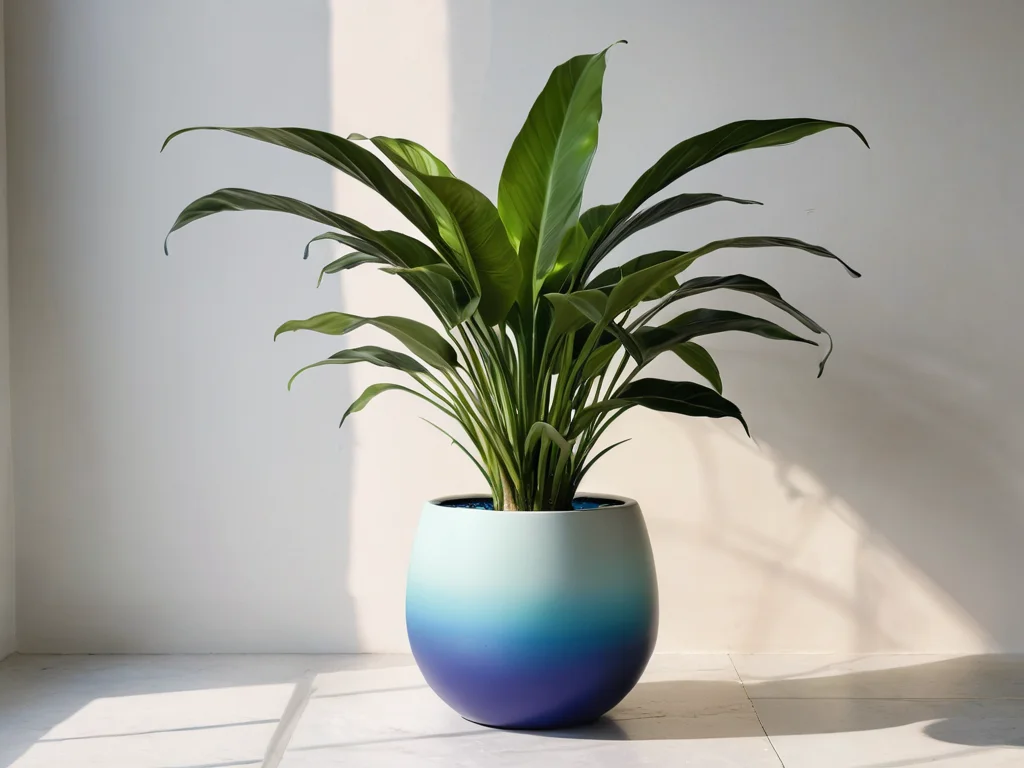Every element in our home, from the largest piece of furniture to the smallest decorative accent, carries a certain energy, or Qi. In the art of Feng Shui, we strive to create a harmonious space where this energy flows freely and contributes to the well-being of its inhabitants. Houseplants, being living beings, are powerful carriers of life force, capable of transforming the atmosphere and filling the home with positive energy. However, for their potential to be fully realized, attention must be paid not only to the plant itself but also to what it is planted in. A plant pot is not just a container; it is a kind of energetic “costume” that can either enhance or weaken its beneficial influence. Choosing the right pot according to Feng Shui becomes not just a matter of aesthetics, but an important step towards creating a truly harmonious and prosperous space.
Energy in Detail: Why a Plant Pot is More Than Just a Container in Feng Shui
In the world of Feng Shui, it is believed that everything is interconnected and influences the environment. Plants bring living energy into the home, symbolizing growth, development, and vitality. But their power can be either amplified or diminished by what they are contained in. A plant pot, seemingly such a minor detail, actually plays a key role in managing the flow of Qi energy.
Imagine a pot as a kind of frame for a living painting. If the frame is poorly chosen – too massive for a delicate watercolor or too fragile for a voluminous canvas – it disrupts the overall harmony. It’s the same with plants: if the pot does not match the energy of the plant itself or the area it is placed in, it can create dissonance. It is believed that the pot acts as an intermediary between the energy of the earth, which the plant draws from the soil, and the energy of the space it is integrated into. It can serve as a conduit, amplifying the life force, or, conversely, blocking its movement. This is why choosing a pot requires a conscious approach based on Feng Shui principles to maximize the plant’s positive impact on your surroundings.
A correctly chosen pot helps the plant thrive, and with it, the energies in your home. It supports the health of the root system, symbolizing a deep foundation and stability, and at the same time harmoniously fits into the interior, promoting the free flow of Qi. We are talking about the fact that a pot doesn’t just hold soil; it forms an energetic shell for the plant, determining how effectively it can radiate its beneficial vibrations. It’s like choosing the right outfit for an important event – it should be not only beautiful but also functional, supporting the overall impression and mood.
The Magic of the Five Elements: How Elements Influence Your Pot Choice
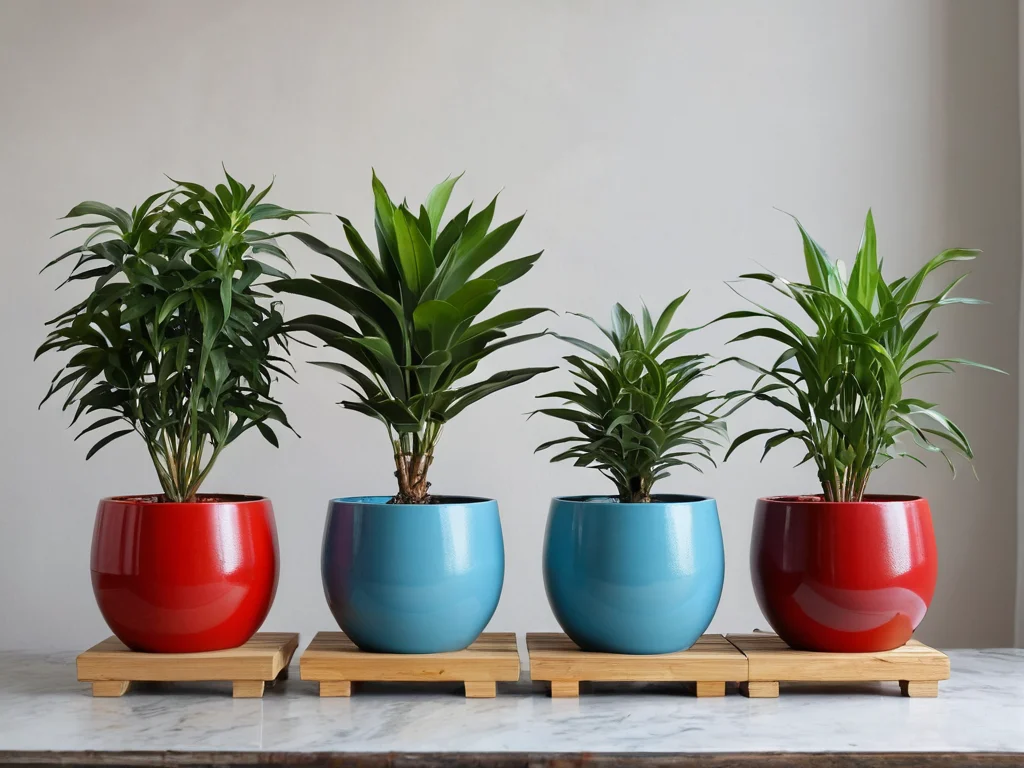
The foundation of Feng Shui is the theory of the Five Elements (Wu Xing): Wood, Fire, Earth, Metal, and Water. These elements are in constant interaction, creating cycles of creation (Wood nourishes Fire, Fire creates Earth, Earth gives birth to Metal, Metal collects Water, Water nourishes Wood) and control (Wood controls Earth, Earth controls Water, Water controls Fire, Fire controls Metal, Metal controls Wood). Understanding these cycles is critically important when choosing a pot, as the shape, material, and color of the pot are closely linked to specific elements.
- Wood Element: Associated with growth, vitality, expansion, health. Corresponds to elongated, rectangular shapes, green and blue colors. Wooden pots, or pots imitating wood, enhance this energy.
- Fire Element: Symbolizes passion, energy, activity, transformation. Corresponds to triangular, pointed shapes, red, orange, purple colors. This element can be represented by red ceramic pots, but requires caution due to its intensity.
- Earth Element: Embodies stability, grounding, fertility, reliability, harmony in relationships. Corresponds to square shapes, yellow, brown, beige colors. Ceramic, clay, stone pots are manifestations of this element.
- Metal Element: Associated with clarity, precision, concentration, wealth, protection. Corresponds to round, spherical, or oval shapes, white, gray, gold, silver colors. Metal pots or pots with metallic decor represent this element.
- Water Element: Symbolizes flow, abundance, communication, wisdom. Corresponds to wavy, asymmetrical shapes, black, dark blue colors. Glass pots or pots with a glossy, reflective surface can represent Water.
When choosing a pot, it is important to consider which element it represents and how this element will interact with the element of the plant, as well as with the element of the area where the plant will be placed. For example, if you have a plant representing the Wood element (most houseplants), a pot made of Earth (ceramic, clay) will be an ideal support for it, as Earth nourishes Wood. A pot associated with Metal (round, white) will weaken Wood, as Metal cuts Wood in the control cycle. However, if the goal is to balance overly vigorous Wood, then the Metal element can be used in moderation. The main thing is to strive for harmony and balance, avoiding obvious conflicts of elements.
The Geometry of Well-being: What Pot Shape to Choose for Different Purposes
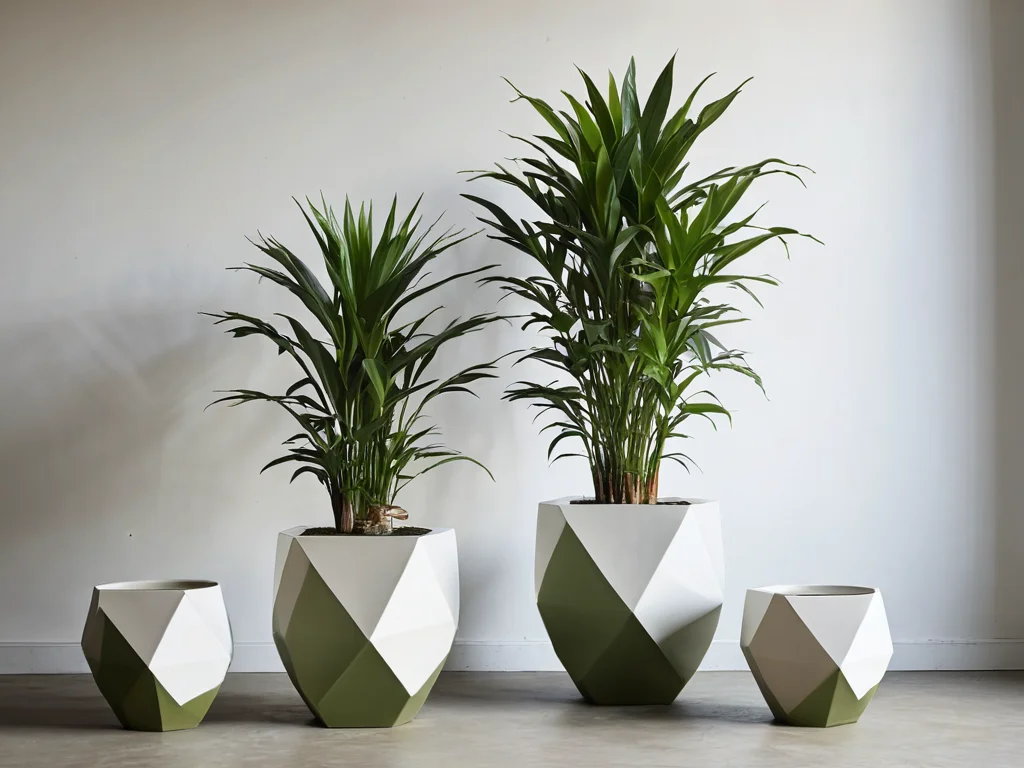
The shape of a pot not only affects aesthetics but also carries a specific energy corresponding to one of the Five Elements. The right choice of shape can enhance desired qualities and create harmony in your space. Understanding the symbolism of each shape allows for a conscious approach to selection, turning the pot into a powerful Feng Shui tool.
- Round Pot: The round shape is considered to be associated with the Metal element. Metal symbolizes money, abundance, movement, new beginnings, and communication. Round pots are ideal for plants placed in areas related to wealth (southeast), career (north), or to enhance creativity and children’s energy (west). They also bring a sense of wholeness and completion. For example, for an office plant that promotes the inflow of new ideas and financial flows, a round pot made of white or gray ceramic would be an excellent choice.
- Square Pot: This shape belongs to the Earth element. Earth symbolizes stability, reliability, grounding, strong roots, as well as harmony in family relationships and partnerships. Square pots are ideal for plants placed in areas related to relationships (southwest), knowledge (northeast), or health (center). They create a sense of security and stability, which is very important for home hearths. For instance, if you want to strengthen family ties or bring more stability into your home, choose a plant in a square clay pot of brown or yellow color.
- Rectangular or Tall Pot: These shapes are associated with the Wood element. Wood symbolizes growth, development, health, vitality, and new beginnings. Such pots are excellent for fast-growing plants or for those you want to stimulate to active growth. They work wonderfully in areas responsible for family and health (east) or wealth (southeast). Rectangular shapes can visually “lift” energy, directing it upwards and forwards, promoting progress.
- Triangular or Pointed Pot: Such shapes are associated with the Fire element. Fire symbolizes passion, energy, fame, and recognition. However, they should be used with caution, as too much Fire can lead to aggression or burnout. They can be appropriate in fame zones (south), but are generally not recommended for most living spaces, as they can create overly active and potentially destructive energy. If you still want to use this element, opt for small accents or softened corners to avoid excessive sharpness.
- Wavy or Asymmetrical Pot: These shapes belong to the Water element. Water symbolizes flow, abundance, wisdom, intuition, and tranquility. Wavy lines bring a sense of movement and flexibility, promoting the free flow of Qi. Such pots can be useful in the career zone (north) or for creating a relaxing atmosphere in a relaxation area. They are ideal for plants that love moisture or for creating a visual effect of fluidity.
When choosing a pot shape, always consider what energy you want to bring into a specific area of your home and what function the plant should serve. The combination of shape, material, and color will create a powerful harmonious ensemble.
The Power of Nature: What Pot Material Will Enhance the Desired Energy

The material of the pot is no less important an aspect than its shape, as it is also directly related to the Five Elements and, consequently, to the energy it brings into the space. Natural materials are considered preferable in Feng Shui, as they conduct living energy better and do not create artificial barriers.
- Ceramics and Clay (Earth Element): These are perhaps the most versatile and recommended materials for pots. Clay and ceramics perfectly embody the Earth element, which symbolizes stability, grounding, fertility, and rootedness. They provide good air circulation for plant roots, allowing them to breathe and thrive. Ceramic pots are especially good for most houseplants, as they create a favorable and stable environment. They are ideal for areas where stability and support are needed, such as the relationship zone (southwest) or health zone (center). Their porous structure also promotes healthier plant growth, and natural colors (terracotta, beige, brown) further enhance Earth energy.
- Metal Pots (Metal Element): Pots made of metal (or with a metallic coating) are associated with the Metal element. This element symbolizes wealth, precision, clarity, efficiency, and protection. Metal pots can be a brilliant addition to areas responsible for wealth (west/northwest) or career (north), helping to activate these energies. They are excellent for modern interiors and can be used for plants with round or compact shapes. However, one should be careful with plants that do not tolerate overheating, as metal can get hot in direct sunlight.
- Wooden Pots (Wood Element): Wooden pots or planters directly represent the Wood element, which symbolizes growth, vitality, health, and development. They are ideal for active plant growth and look great in an eco-style. Wooden pots will be particularly useful in the family and health zones (east) and wealth zones (southeast), as they enhance the energy of these sectors. It is important to ensure that the wood is treated in such a way that it does not rot from moisture and does not harm the plant.
- Glass Pots (Water or Metal Element): Glass can represent both the Water element (transparency, fluidity) and the Metal element (if it is white or gray). Transparent glass vases with water for hydroponic plants or plants growing in water clearly belong to the Water element, symbolizing abundance, flow, and communication. They can be useful in the career zone (north). Glass pots also bring a sense of lightness and airiness, but their use for regular plants with soil may be less practical due to the lack of drainage holes and possible root overheating.
- Plastic Pots: In Feng Shui, plastic, being an artificial material, is generally not a preferred choice. It is believed that it does not conduct energy as effectively as natural materials and can even create stagnation. If you do use a plastic pot (e.g., as an inner container), it is recommended to place it in a more aesthetically pleasing and energetically correct outer planter made of natural material. If a plastic pot is the only option, choose one in colors corresponding to the Earth or Wood elements (green, brown) to minimize negative impact.
When choosing a pot material, always prioritize natural materials. They are not only more beautiful but also possess better energetic properties, promoting healthy plant growth and harmonious Qi flow in your home.
A Pot as an Extension of the Plant: Ideal Pairs for Prosperity
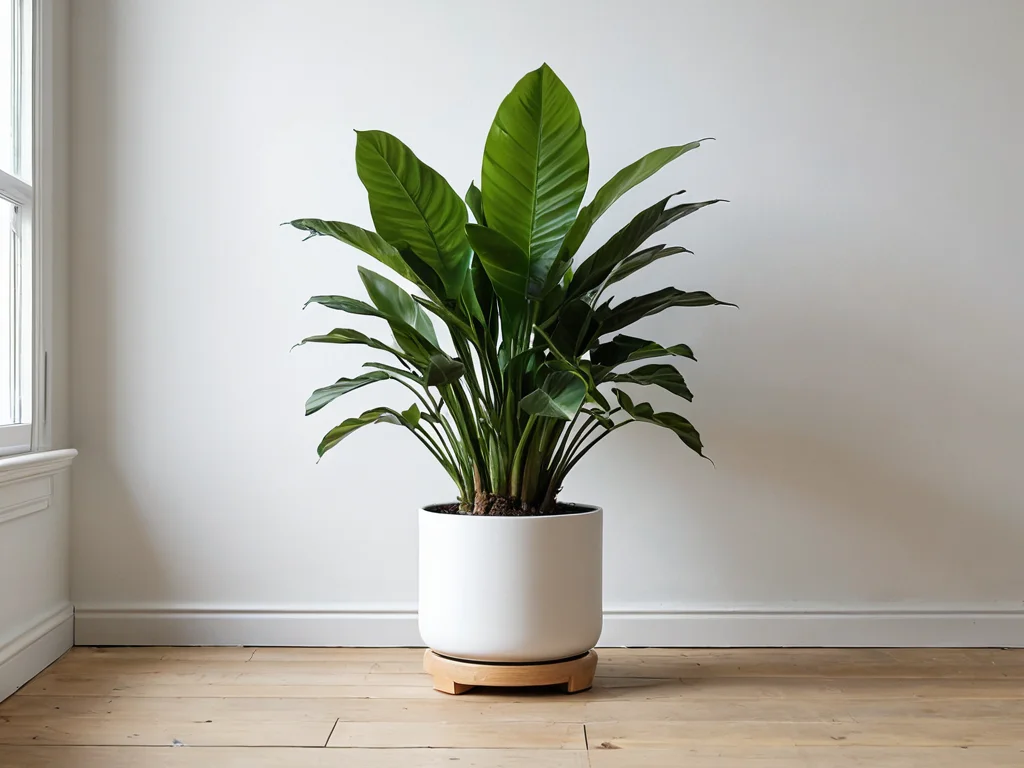
In Feng Shui, there is a principle of harmony and correspondence. A pot should not just be a beautiful container but a natural extension of the plant itself, enhancing its natural qualities and energy. It’s like a well-chosen frame for a precious stone: it should accentuate its beauty, not distract from it. When a pot and plant create an ideal pair, they work in unison, maximizing the inflow of beneficial Qi into your home.
To create an ideal pair, consider the type of plant, its shape, growth rate, and energy, and then choose a pot that will match these parameters according to the Five Elements principles.
- Lush, Tree-like Plants (Wood Element): These include ficuses, dracaenas, monsteras, and other plants with strong stems and abundant foliage. The element of these plants is Wood, symbolizing growth and development. Ideal choices for them would be pots representing the Earth element (ceramics, clay) or Water element (wavy shapes, dark blue color). Earth nourishes Wood, providing stability and support for its growth, while Water is also a supportive element for Wood. Choose square or rectangular pots made of natural clay or ceramic to create a powerful union. For example, a large ficus would be perfectly complemented by a massive terracotta pot.
- Plants with Sharp, Sword-like Leaves (Fire/Wood Element): Plants like Sansevieria, agave, yucca, possess a more aggressive, fiery, or woody energy due to their shape. To soften their energy and make it more harmonious, it is recommended to use pots associated with the Earth or Metal elements. Round metal or white ceramic pots (Metal) will help smooth out the sharpness and bring in the energy of clarity and protection. Square clay pots (Earth) will provide grounding. Avoid sharp, triangular pot shapes to prevent amplifying aggressive energy.
- Succulents and Cacti (Earth Element): These plants often symbolize endurance and survival. Their rounded or compact shapes, as well as their ability to store moisture, are often associated with the Earth element. Ideal for them would be pots made of natural clay, stone, or ceramic in neutral earthy tones (beige, brown, sand). Shapes can be either square (for stability) or round (for the inflow of well-being). Small succulents in miniature square pots look very harmonious and create a cozy feel.
- Flowering Plants (Fire Element): Bright flowers bring the energy of joy, passion, and Fire. To support this bright, but sometimes overly active energy, it is good to use pots associated with the Earth or Wood elements. Clay pots (Earth) will provide stability and rootedness, preventing the Fire energy from becoming too chaotic. Wooden or tall pots (Wood) will also support flowering, as Wood nourishes Fire. Red pots, if not too aggressive, can be used in fame zones (south), but in general, it is better to choose neutral colors so that the flowers themselves remain the bright accent.
- Plants with Trailing Branches (Water/Wood Element): Ivies, tradescantias, ferns with trailing foliage are associated with fluidity and flexibility. Pots that enhance the Water energy (wavy shapes, dark blue color) or Earth energy (stable base) are suitable for them. Hanging planters made of natural materials or ceramic pots with soft, rounded shapes would be an excellent choice, as they support the natural movement of the plant and create a sense of flow and abundance.
Remember that the pot should be proportionate to the plant. A pot that is too large can overwhelm the plant and create a sense of loss, while one that is too small will restrict its growth and development, symbolizing stagnation. The ideal pot should be proportionate to the plant, allowing it to develop freely and fit harmoniously into the overall design.
Where to Place and What to Use: Choosing a Pot for the Zone and Goal in the Interior
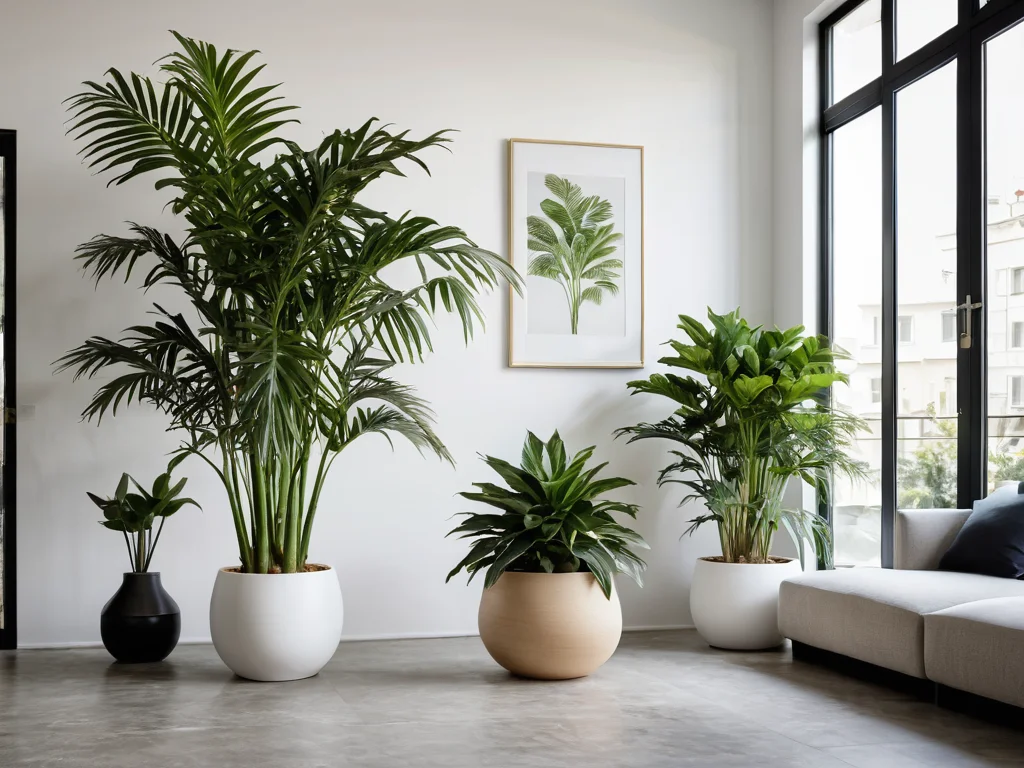
The placement of plants and the choice of pots for them should be inextricably linked to the Bagua zones of your home and the goals you want to achieve. Each zone in a home or office is associated with a specific element, color, and aspect of life. A correctly chosen pot can enhance the energy of this zone, activating the necessary Qi flows.
To determine the Bagua zones, a grid is usually used, superimposed on your home’s floor plan, oriented by cardinal directions or the entrance door. Let’s consider which pots would be most appropriate in different sectors:
- Wealth Zone (Southeast): Associated with the Wood element and colors of green, blue, purple. To activate financial energy, it is recommended to use plants with lush foliage, symbolizing growth. Ideal pots would be those that support Wood:
- Material: Wooden, ceramic (Earth nourishes Wood).
- Shape: Rectangular, tall (Wood), round (Metal creates Water for Wood).
- Color: Green, blue, brown, as well as gold or purple for enhancement.
For example, a money tree in a wooden or brown ceramic pot with a rectangular shape.
- Fame and Reputation Zone (South): Related to the Fire element and colors of red, orange. Bright, flowering plants are appropriate here.
- Material: Ceramic (Earth controls Fire to avoid excess, or Wood, which nourishes Fire).
- Shape: Rectangular (Wood), but small accents of pointed shapes can be used without overdoing it.
- Color: Red (but moderately), green.
For example, a hibiscus in a green ceramic pot.
- Love and Relationship Zone (Southwest): Associated with the Earth element and colors of yellow, brown, pink. It is good to place paired plants or plants with soft, rounded leaves here.
- Material: Ceramic, clay, stone (Earth element).
- Shape: Square (Earth), round (Metal).
- Color: Yellow, brown, pink.
For example, two violets in paired square clay pots of pink or yellow color.
- Family and Health Zone (East): Related to the Wood element and green colors. Plants symbolizing health and growth are ideal.
- Material: Wooden, ceramic (Earth).
- Shape: Rectangular, tall.
- Color: Green, blue.
For example, bamboo in a green rectangular pot.
- Knowledge and Wisdom Zone (Northeast): Associated with the Earth element and colors of beige, yellow, light blue. Plants that promote concentration are suitable.
- Material: Ceramic, clay.
- Shape: Square.
- Color: Yellow, beige, light blue.
For example, a bonsai in a square clay pot.
- Career and Life Path Zone (North): Related to the Water element and colors of black, dark blue.
- Material: Glass (for aquatic plants), metal (Metal creates Water).
- Shape: Wavy, asymmetrical (Water), round (Metal).
- Color: Black, dark blue, gray, white.
For example, a plant in a transparent vase with water or in a round metal pot.
- Helpful People and Travel Zone (Northwest): Associated with the Metal element and colors of white, gray, silver.
- Material: Metal, ceramic (Earth gives birth to Metal).
- Shape: Round.
- Color: White, gray, gold, silver, yellow.
For example, a sturdy plant in a round metal or white ceramic pot.
- Children and Creativity Zone (West): Related to the Metal element and colors of white, silver.
- Material: Metal, ceramic.
- Shape: Round.
- Color: White, gray, pastel tones.
For example, a flowering plant with rounded leaves in a round white pot.
It is important to remember that Feng Shui is not a strict set of dogmas, but a flexible tool for creating harmony. If a particular pot or plant intuitively appeals to you, listen to your inner voice, but always try to balance the elements as much as possible to achieve the best result.
Feng Shui Pitfalls: Avoiding Common Mistakes When Choosing a Pot
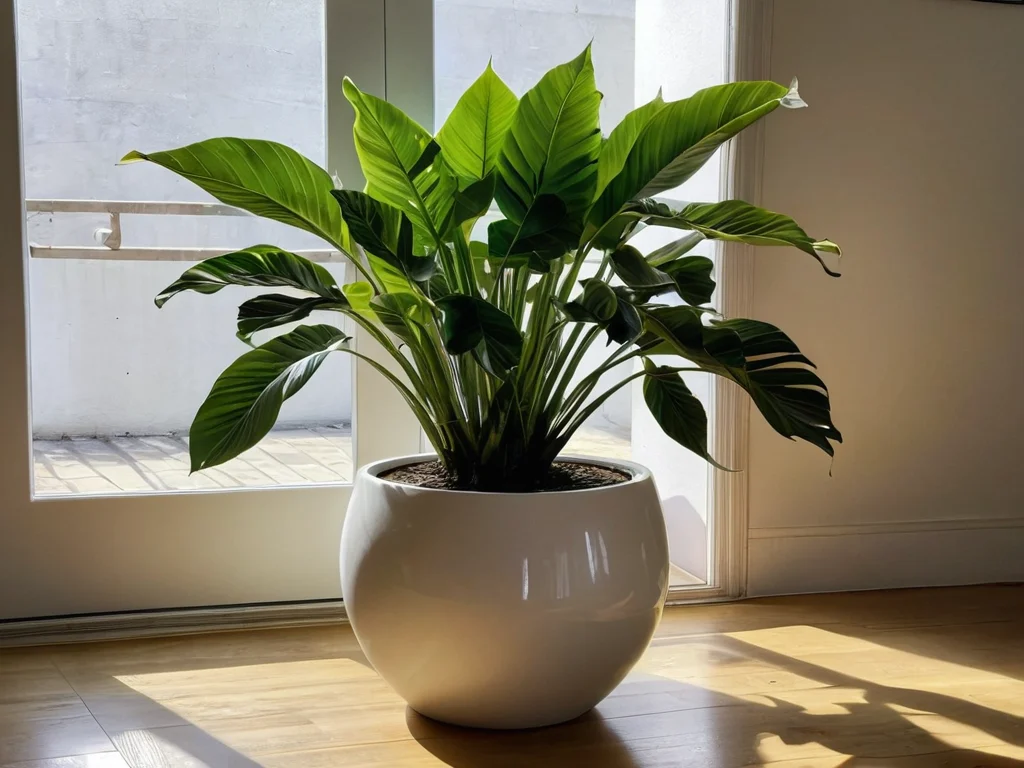
Even with the best intentions, mistakes can be made that, from a Feng Shui perspective, can disrupt harmony and block positive energy. A conscious approach to choosing a pot is not only about knowing the rules but also about knowing how to avoid common pitfalls.
- Mismatch of the pot’s element with the plant/zone: This is one of the most common mistakes. For example, placing a Wood element plant (most houseplants) in a Metal element pot (round, white metal pot) in a zone that also does not support Metal. Metal cuts Wood, creating a conflict that can manifest as health problems or stagnation in matters related to the zone. Always check the creation and control cycles of the Five Elements to avoid such conflicts. The pot should support or harmonize the energy of the plant and the zone.
- Using damaged or cracked pots: Broken, cracked, chipped, or dirty pots symbolize deficiency, damage, and negativity. They are believed to attract misfortune and weaken the life force of the plant and the surrounding space. Damaged items should be immediately disposed of or repaired (if possible without losing aesthetics) to prevent the leakage of positive Qi from your home.
- Pots that are too large or too small: The size of the pot should be proportionate to the size of the plant. A pot that is too large can create a sense of loss, loneliness, or oppression for the plant, symbolizing that it lacks support to fill that space. It can also lead to overwatering of the soil. A pot that is too small, on the other hand, will restrict root growth and, consequently, plant development, symbolizing stagnation, lack of resources, and lack of opportunities for growth in the lives of the home’s inhabitants. Always choose a pot that allows the plant to grow freely but does not seem empty.
- Low-quality artificial materials (e.g., cheap plastic): As mentioned earlier, natural materials are preferred. Plastic, especially cheap and low-quality, can create static energy, blocking the natural exchange of energy between the plant and the environment. It is believed to introduce artificiality and a lack of vitality. If you are forced to use plastic, ensure it is high-quality, dense plastic and use it as an inner technical pot that will be hidden by an outer planter made of natural material.
- Pots with aggressive patterns or colors: Overly bright, loud, aggressive colors or patterns (e.g., with sharp angles, angry faces, chaotic designs) can create tension and discomfort. They are believed to attract negative energy or create energetic imbalance. Opt for calm, harmonious colors and patterns that match the element of the zone and do not overload the space.
- Pots without drainage holes or with constant water stagnation: While this may seem like a matter of plant care, from a Feng Shui perspective, water stagnation in the saucer or lack of drainage symbolizes stagnation in affairs and energetic blockages. Rotting water or roots create negative Sha Qi energy, which harms well-being. Ensure the pot has good drainage and excess water is regularly removed from the saucer, maintaining cleanliness and freshness.
Paying close attention to these details will help you create not only a beautiful but also an energetically strong home where plants will thrive, bringing luck and harmony.
Your Home is Your Oasis: Creating Harmony with the Right Pots
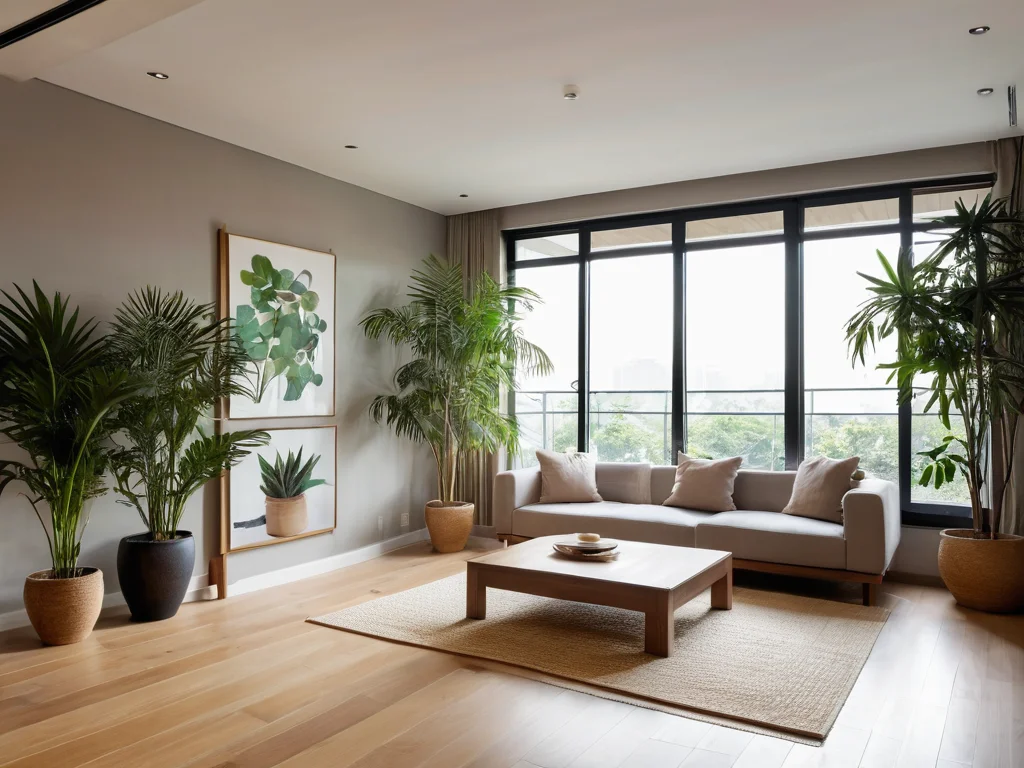
We have come a long way, exploring the intricacies of choosing plant pots according to Feng Shui, and now you possess deep knowledge to transform your home into a true oasis of harmony and prosperity. Remember that every choice you make regarding your living space matters and affects the energy flows that shape your life.
By applying Feng Shui principles to your pot choices, you do much more than just improve the aesthetics of your interior. You create a conscious connection between living nature, your space, and your life goals. You invite the energy of growth, stability, abundance, and love into your home, supporting it with the shape, material, and color of each pot. It is believed that when you choose a pot, you are essentially choosing what energy you want to enhance or attract into your life.
Now that you are armed with this knowledge, it’s time to act. Walk around your home, take a fresh look at your plants and their pots. Perhaps a small adjustment is needed somewhere, and elsewhere – a completely new approach. Do not be afraid to experiment and trust your intuition. Feng Shui is not a rigid set of rules, but rather a set of recommendations that help you tune into the frequency of harmony and well-being. Your intuition, backed by Feng Shui wisdom, will be your best guide.
Let your plants be not just decorative elements, but powerful amulets and activators of positive energy. Let each pot be a thoughtful choice, reflecting your aspiration for a harmonious and happy life. Your home is your sanctuary, and you are its chief architect. Create it with love, attention, and wisdom, and it will surely reciprocate, filling each day with luck, health, and well-being.
